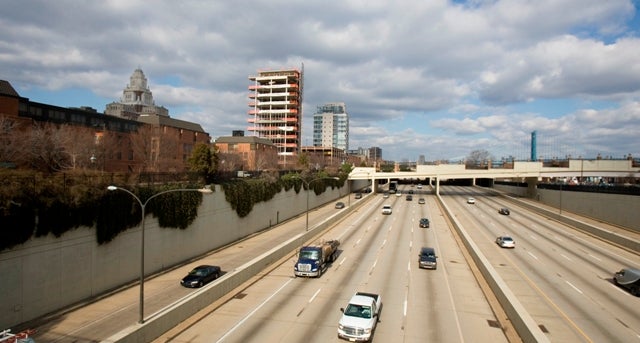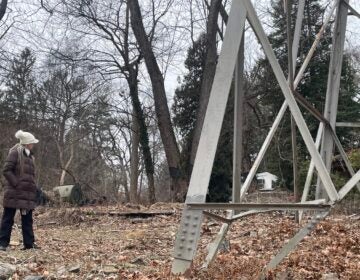Experts see river by boat, bus

FOX Good Day interviews Harris Steinberg, Mar. 6
Inga Saffron: Take note of waterfront plan Mar. 9
Harris Steinberg interviewed by WPHT
March 1
By Matt Blanchard and Linda K. Harris
For PlanPhilly
Design teams tackled Philadelphia’s complicated waterfront by land and by sea on Thursday, kicking off a three-day marathon to generate visionary concepts for the seven miles of the Central Delaware Riverfront.
Skimming up river on a 65-foot Coast Guard cutter, local and international architects squinted back at the city of Philadelphia and struggled to discern some method in the mad tableau of crumbing piers, empty lots, shipping terminals, power plants and big box retailers.
Later, the team would ply a parallel route by bus, disembarking to walk key sites along Delaware Avenue.
The goal: To achieve inspiration – or at the very least, to make some sense of the rude reality left behind by 50 years of bad planning.
Steadying herself against the pilothouse of the USS Capstan, venerable Philadelphia architect Denise Scott Brown saw rich opportunity along the shoreline.
“All these different systems – transportation and land use, the environmental heritage, the places where land and water meet, the patterns of intensity, relations between public and private – that’s the palate of colors I work with,” she said.
The next day, Scott Brown was to lead one of five teams tackling various segments of the waterfront, including the north, central, and southern portions, as well as Delaware Avenue. Scott Brown was to examine connections between neighborhoods and the waterfront.
“There’s a lot we don’t know,” Scott Brown said. “And we don’t know how much can be figured out in a three-day charette.”
South Philadelphia by Sea
Launching from the Coast Guard station at Washington Ave, the ship first headed south past an array of uses: A heliport, parking lots, a Comcast service center, and the future site of the proposed Foxwoods casino.
“None of which has anything to do with the river,” remarked Harris Steinberg, director of PennPraxis.
Steinberg’s point was soon proven by the low, grey back of Wal-Mart – one of four big-box retailers sited on prime waterfront in South Philadelphia. The parking lot slopes down to three vacant piers at the water’s edge, making it the world’s only waterfront Wal-Mart, Steinberg quipped.
Later that day, during the bus tour, the architects would watch with astonishment as crew from a tugboat landed at the Wal-Mart piers and snuck through a chain-link fence to go shopping.
Next came the majestic classical facades of 1920s piers 78 and 89. Here ships disgorge steel from Japan, cocoa beans from Africa and South America, yet often leave empty since Philadelphia exports little.
Neighboring piers have collapsed into ruin, leaving behind rows of wooden pilings like rotten teeth. And beyond them rose the brick colossus of Excelon’s Southwark power station.
String of Pearls
This diversity of conditions and uses poses a real challenge for designers, said Gary Hack, Dean of the University of Pennsylvania’s School of Design.
Rather than the continuous waterfront trail residents have openly advocated, public access may, by necessity, remain fragmented for years to come.
“I think it’s going to be very hard to work out a system of waterfront access on every pier,” Hack said. “Some of the piers are quite narrow, and if you’re going to use them for anything, it’s going to be very hard to get decent waterfront access.”
“I think a more likely scenario is that we have some connection along the boulevard, a walking space,” he said, employing the image of a “string of pearls.” The pearls are sites of public access carved out of the existing landscape. The string is an improved, pedestrian-friendly Delaware Avenue.
Romantic Ruins
Also on board the ship was German landscape architect Peter Latz, whose most famous projects involve the reuse of abandoned industrial sites to stunning effect. Latz’s Landschaftspark, in Duisburg, Germany, transformed a rusted blast furnace by weaving in plant life and public spaces. See his work at: www.latzundpartner.de/index.htm. Latz will lead the team investigating the northern segment of the study area: Fishtown and Port Richmond.
With so much industrial ruin, Philadelphia could keep Latz busy for a lifetime. Out on the water, the architect said little but gazed fixedly at several sites along the water’s edge, taking photos of the striking Delaware Power Station, an abandoned power plant north of Penn Treaty Park.
Less taciturn was Scott Brown, who shares Latz’s enthusiasm for the industrial past.
“It’s incredibly romantic, isn’t it?” she said as the ship passed a once-busy pier now tangled in vegetation. “It’s romantic and forlorn.”
The pier in question was old Pier 18, whose raised concrete bridge once carried coal cars but now carries graffiti. In Scott Brown’s plan, the pier would be stabilized, preserved and kept around as a romantic ruin.
“See how people have decorated this pier?” she said of the graffiti. “It’s a kind of ruin in the English Romantic landscape tradition. Except this ruin is real, and wasn’t built by somebody to look old. It’s a treasure.”
The Bus Tour
Shortly after 3 p.m. an expanded group of 40 people climbed aboard a bus for the second leg of the tour.
Leaving from the Independence Seaport Museum at Penn’s Landing, the bus headed north toward the Penn Praxis study’s northern boundary at Allegheny Avenue. The bus rolled past Race Street, under the Benjamin Franklin Bridge, past Spring Garden.
Steinberg, the director of Penn Praxis, the clinical arm of the School of Design of the University of Pennsylvania, led the bus tour and spoke of the mission. “That is part of our charge, to balance private development and public development,” he said.
As the bus continued, Waterfront Square, two new condominium towers, were visible through the bus windows, the Sugar House Casino sign, the Kawa Corp., the Henry Stewart Co.
Penn Treaty Park
The bus made its way to Penn Treaty Park, two to three acres of green space. The overcast gray skies appeared to mock the idea of green.
“You don’t get too much a feel for it in the bleak wintry time,” Scott Brown said. But she thought it looked as if there had already been some attempts at landscape design.
Gary Hack, another group leader for Friday and the dean of the School of Design at the University of Pennsylvania, said the site had potential. “At some point we have to pry it loose and do something with it,” he said.
Laura Lanza, a Port Richmond activist, is focused on mixed uses for the public lands to be developed. She’s advocating trails and even a museum.
The Pinnacle Site
At a stretch of land owned by Jim Anderson, Scott Brown raved about what appeared to be a rundown brick industrial leftover. “It’s really a symphony of a building,” she said. One of the larger stretches of land along the river and just across from Petty’s Island, Scott Brown allowed as how she thought the area might make a good campground. “It would be nice to pitch a tent.”
Penny Bach, who works with the Fairmount Park Art Association, thought the large industrial building might make a good art space, and Scott Brown agreed, especially “for large-scale sculpture.”
The Ben Franklin Bridge: Underachiever?
Standing on the shore of the Pinnacle site, one designer cast an astonished look back toward the Ben Franklin Bridge making its blue span across the river to Camden.
Loay Abdelkarim is a senior structural engineer for the Boston firm ARUP. He’s worked all over the world – across the United States and the Middle East – yet he had never laid eyes on the Ben Franklin Bridge until that day.
“This is one of the finest suspension bridges I’ve ever seen. But it’s never been marketed,” Abdelkarim said. “When I start to work on a bridge, I look for inspiration to the George Washington Bridge, or to San Francisco. I didn’t even realize we had these two beautiful structures here.”
Abdelkarim said the forces of Paul Cret-designed 1920s span are elegantly captured by the structural design. “I don’t see any waste. It’s just perfect.”
Why, then, had he never seen it? Why, then does Philadelphia not market this dynamic piece of infrastructure like so many other cities across the world? And why, he asked, was the spot he stood on, with such a sweeping view of the river, still a vacant lot?
Pulaski Park
Everyone piled on the bus, which made its way up Richmond Street and turned right at Allegheny Avenue headed toward Pulaski Park, a diminutive jut of land, that nevertheless attracts people yearning for a river fix.
Mami Hara, a landscape architect with the firm Wallace Roberts & Todd, charged with taking the ideas and charette designs and forging a definitive plan, talked about the industrial context that surrounded the small space of land. She said it was important “to create a dialogue with the context, provide views, provide access to the water.”
What is industry’s relationship to the other programs on the waterfront in the 21st century, she asked. “I’m not saying this industry needs to go but it can be reimagined.”
Laura Lanza said even a small park such as Pulaski required a lot of upkeep.
“In spite of all the graffiti you see, this is one of the most used parks by families, people from West Kensington, fishing and picnicking.”
But she said the park and other public places along the riverfront would need a management organization. “Unless there becomes a riverfront management group, we can’t do what we want to do.”
As the bus turned south, Nancy O’Donnell of the Pennsylvania Horticultural Society’s Philadelphia Green program, said she believed people really appreciated the authenticity of Philadelphia, unlike newer cities and planned destinations such as Disney World. “A lot of cities look like it’s been all slapped up.”
O’Donnell said she thought it was important to make the public spaces attractive to a variety of people, and she added that a fireboat might create quite a draw.
WHYY is your source for fact-based, in-depth journalism and information. As a nonprofit organization, we rely on financial support from readers like you. Please give today.






